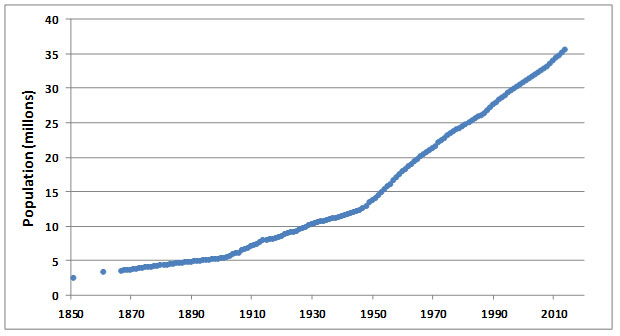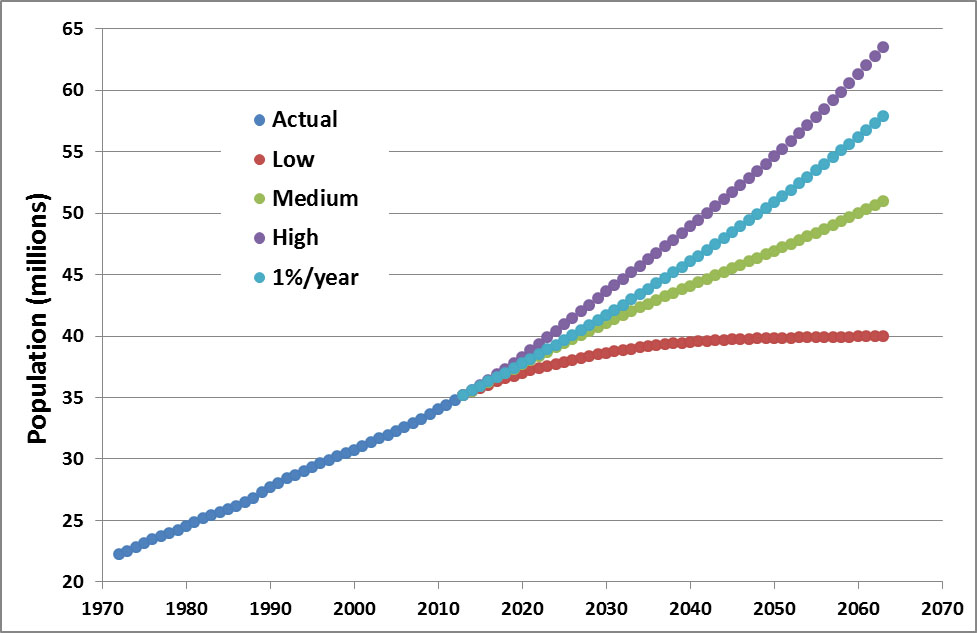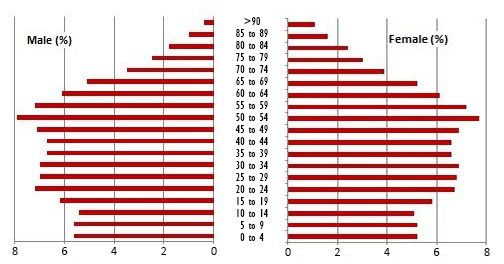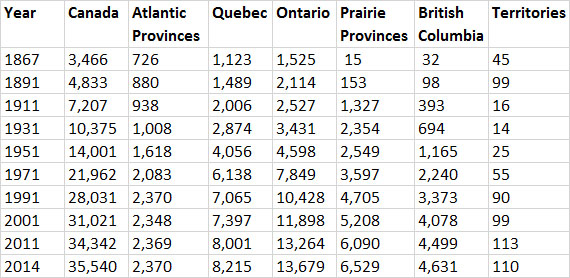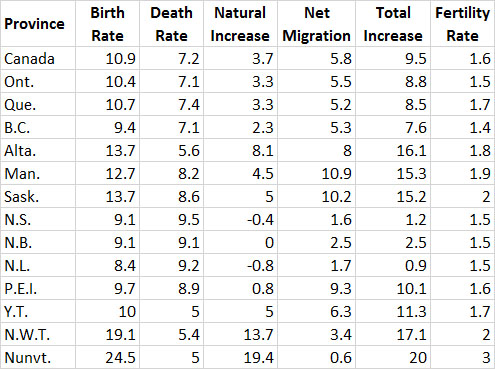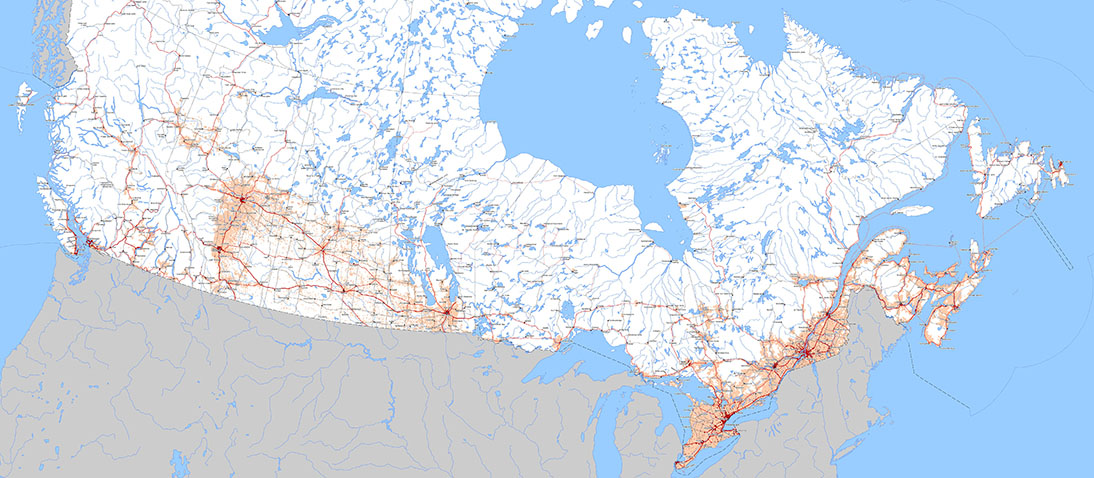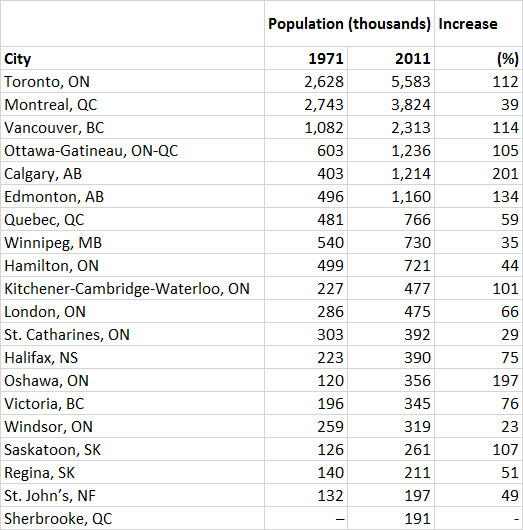Chapter 11 ~ The Canadian Population
Key Concepts
After completing this chapter, you will be able to:
- Outline changes in the Canadian population over time.
- Describe the recent populations and demography of the provinces and territories of Canada.
- Describe the urbanization of Canada.
- Discuss the desirability of a population policy for Canada.
Introduction
In Chapter 10 we examined the dynamics of human populations in different countries as well as on a global scale. This information provides an international context for the examination of population issues in Canada. Canada ranks among the top 20% of nations in terms of its human population (about 36 million in 2015). Canada also ranks among the wealthiest of nations in terms of per-capita indicators of economic development, use of natural resources, and impacts on environmental quality (see Chapter 1). Because Canadians have an environmentally intensive lifestyle, our country has a much greater impact on Earth and its resources than would be predicted on the basis of its population alone.
Image 11.1. Although population densities are high in Canadian cities (illustrated by this crowd listening to musical buskers in Halifax), they are relatively low in the country as a whole. Most of Canada is not suitable for supporting a large population, mainly because of a difficult climate. Source: B. Freedman.
Because Canada has achieved a relatively high level of economic and social development, it has an opportunity to manage its environmental quality in a sustainable manner. Canada also has a responsibility to control its population growth within sustainable limits. Moreover, because of our privileged and wealthy status, Canada has an obligation to demonstrate a vision of sustainability to other nations, including less-developed countries that are hoping to emulate our achievements. A central element of sustainable development is the implementation of a sensible population policy.
It is important that Canadians become knowledgeable about national and global population issues. If Canadians understand these subjects, they will be sympathetic to population policies that are appropriate within Canada, as well as abroad.
Aboriginal Populations
Around 1000 CE, the Norse explorer Leif Ericsson made several landfalls along the northeast coast of North America. The Norse attempted a colonization, including a settlement at l’Anse aux Meadows in Newfoundland, but that quickly failed. About 500 years later, other European explorers encountered vast regions in the Americas that had previously been unknown to them. They did not, however, find unpopulated lands. In fact, all of the Americas were fully occupied by various indigenous or Aboriginal cultures (consisting of First Nations or Amerindians, plus the northern Inuit). At the end of the fifteenth century, at the time of the voyages of Christopher Columbus and John Cabot, the indigenous peoples of the Americas had an estimated population of about 35 million people. About 30 million of these people lived in South and Central America, and 5 million in North America.
Some of the First Nations had developed advanced cultures and economies, particularly the Aztecs and Maya of Central America and the Inca of South America. These people built elaborate cities that contained great pyramids and other impressive buildings. Their nations were supported by complex physical and social infrastructures. Like cities everywhere, those of the more advanced Amerindian societies relied on the surrounding agricultural landscape to supply food, water, and other resources. Furthermore, taxes were collected from people living in the producing regions to support the rulers, administrators, soldiers, and artisans who were living in the urbanized centers.
The First Nations cultures in what is now Canada were diverse, comprising 12 language groups, some of which had many dialects. Some of the cultures, such as the Huron and Iroquois of the eastern temperate woodlands, were essentially agrarian societies. These people supplemented their agricultural livelihood by foraging for useful wild plants and by hunting deer, birds, fish, and other animals. They lived in grand longhouses in stockaded villages, surrounded by well-tended fields in which they cultivated maize, beans, pumpkin, squash, sunflower, and other crops.
Other First Nations subsisted largely through hunting and foraging lifestyles. The Bella Coola, Haida, Nootka, Tlingit, and related nations of the humid Pacific coast exploited a relatively abundant and predictable resource base, and consequently, they lived in permanent settlements. These people were mostly fishers of salmon, molluscs, and additional coastal resources, supplemented by wild plants, deer, and other terrestrial resources.
Most of the First Nations of the western prairies, such as the Assiniboine, Blackfoot, and Piegan, were semi-nomadic hunters of the enormous herds of bison and other prairie animals that existed at the time. The more northern Athapaskans, Chipewyan, Cree, Dene, and Innu of the sweeping boreal forest hunted caribou, moose, beaver, and waterfowl, and fished for grayling, trout, whitefish, and pike. The Beothuk, Mi’kmaq, and Maliseet of the Atlantic region also hunted moose, deer, and caribou, fished in freshwaters, and gathered shellfish in shallow coastal waters. All of these peoples also gathered wild plant foods when they were abundant. The northernmost Inuit were the most recent Aboriginal migrants to Canada. They subsisted on marine mammals, such as ringed seal, walrus, beluga, narwhal, and even great bowhead whales. They also hunted caribou when those migratory animals were nearby.
Not much is known about the population sizes of these Aboriginal nations of what is now Canada. Estimates are based on assumptions about their lifestyle and the presumed carrying capacity of their habitats. At about the time when the first Europeans came to Canada, the total Aboriginal population may have been about 300,000.
European Contact
The European colonization of the Americas began in the early sixteenth century, following the “discovery” of these lands in 1492 by Christopher Columbus, who was a Genoan sailing on behalf of the Spanish Crown. Columbus was seeking an oceanic passage to the rich spices and silks of China, India, Japan, and Southeast Asia, but he blundered on the Americas, with his first landfalls occurring in what are now the Bahamas, Cuba, and Hispaniola. In 1497, John Cabot, also a Genoan but employed by the King of England, sighted Newfoundland and possibly Cape Breton.
Soon after the arrival of the Europeans, the numbers of Aboriginal people began to precipitously decline. By the end of the nineteenth century, the Amerindian population of North America was only about 20% of their initial 5 million. The most important causes of this calamitous mortality were infectious diseases, particularly measles, smallpox, tuberculosis, and influenzas. Europeans were relatively tolerant of these diseases that they brought to the Americas, but the indigenous peoples were extremely vulnerable. Epidemiologists refer to populations that are hypersensitive to infectious diseases as “virgin fields”. Such populations can suffer intense mortality from introduced diseases (known as virgin-field epidemics).
In addition, huge numbers of Aboriginal peoples died as a direct and indirect result of conflicts associated with the European conquest. Others died during inter-tribal wars, some of which were precipitated when competing European nations upset previous balances of power among indigenous groups, in part by providing their Aboriginal allies with advanced weaponry. In addition, many people starved when they were dispossessed of their resources and livelihoods by European colonists and governments. For example, the rapacious 19th-century slaughter of the great bison herds was partly a stratagem to deprive the Plains First Nations of their crucial resource base.
In 1500, there were about 300,000 indigenous people in Canada, a population that subsequently collapsed to perhaps 60,000. The Aboriginal nations of Canada now number about 1.4 million people whose self-identified ancestry is First Nation (or Indian; 852-thousand), Métis (452-thousand), or Inuit (60-thousand) (2011 data; Statistics Canada, 2012).
Early European Immigration
The initial wave of Europeans coming to Canada were mostly French and British adventurers seeking furs, fish, timber, agricultural land, trade, and colonial lands. Compared with their European homelands, which even then were relatively densely populated, Canada represented a great frontier to these colonists, replete with boundless opportunities to develop livelihoods and make money. The fact that these lands were already occupied by Aboriginal cultures did not matter much to the European colonists because the dominant world views of the time were aggressive and imperialist. These beliefs served to legitimize the displacement of indigenous peoples by the technologically empowered Europeans.
Slowly over the first century or so, and then as a great flood of immigration, colonists came to Canada from France and Britain, and later from many other countries. Today, the population is an amalgam derived from a rich diversity of immigrants from virtually all parts of the world, plus descendants of the original Aboriginal cultures.
Between 1500 and 1700, the population of the North American continent increased to about 6 million people. This included about 1 million black slaves, who had been brought unwillingly from Africa to the southeastern colonies to work on plantations. Under laws of the time, slaves were the human property of their “owners,” having no personal freedom and few rights. Although people in the northern colonies had few slaves, they did employ large numbers of indentured servants, mostly of European origin, who were bound to their employers by contracts and debts that in many cases were impossible to pay off. Those difficult obligations were not much removed from slavery.
Following this initial phase of colonization, the pace of immigration markedly quickened. Data are not available for the entire period, but between 1820 and 1930 at least 50 million persons of European birth migrated to colonies and former colonies around the world, but particularly to the Americas. This immense human dispersal involved about one-fifth of the population of Europe during the period. The mass migration was stimulated by a combination of factors: rapid population growth in Europe, a shortage of arable land there, famine in Ireland and other countries, and rivalries among the imperial powers to develop empires and dominate world trade. In addition, some religious and ethnic minorities were heavily persecuted in European countries, and this persuaded many of those oppressed peoples to emigrate to North America or elsewhere.
As was noted in Chapter 10, this great 19th and 20th-century dispersal was a critical factor in allowing European countries to have a relatively easy passage through their demographic transitions.
Canadian Focus 11.1. The Legacy of Daniel LeBlanc and Françoise Gaudet
In 1650, Daniel LeBlanc emigrated from France to Acadia. He married Françoise Gaudet, also an immigrant, and settled into subsistence farming near what is now Annapolis Royal in Nova Scotia. Many families during that time were large, which was considered a good thing because children helped with the onerous labour of clearing the forest, tending crops and livestock, and taking care of the home and extended family. In fact, fecundity remained high among French Canadians for more than three centuries until the 1950s and 1960s, when birth rates began to plummet.Daniel and Françoise had seven children – six sons and a daughter. Five of their sons married, presenting Daniel and Françoise with 35 grandchildren. Today, the LeBlanc family has an enormous legacy of descendants, estimated to number more than 300,000 in Canada and the United States (many have the anglicized surname White). The LeBlanc clan is the largest of the Acadian lineages. This extraordinary case demonstrates the awesome power of human population growth.
Canadian Focus 11.2. A Remarkable Legacy of New France
The best early demographic data for any area of Canada are for New France. This region encompassed the valley of the St. Lawrence River in southern Quebec, and the Acadian regions of what are now Nova Scotia, New Brunswick, and Prince Edward Island.The French effort of colonization began in 1604, when Samuel de Champlain led an expedition that settled near Annapolis Royal in the lower Bay of Fundy, followed by another mission that founded Quebec City in 1608. In the early 1600s, there were about 500 French colonists in the region known as New France. In 1663, after a half-century of tentative colonization, a census reported 3,215 people of French origin in Quebec, while another in 1671 found about 400 in Acadia. Most were single men who had journeyed to the Canadian frontier as soldiers, as priests hoping to convert indigenous people to Roman Catholicism, as government administrators, or as adventurers seeking their fortune through the fur trade.
In the following decade, the pace of colonization quickened markedly because of renewed sponsorship by the French government. Many families of settlers arrived from France, intent on developing agriculture in the fertile lowlands of Acadia and along the St. Lawrence River. The immigration of single women was also encouraged to offset a substantial deficit of females in New France. Many of these young women were recruited from Parisian orphanages and were known as les filles du roi. In 1673, there were about 6700 Francophones in New France.
Immigration then greatly slowed because royal sponsorship of emigrants ended and there were also dwindling prospects for finding work in the colonies. French immigration to Acadia ceased when that area was ceded to Britain in 1713, and it terminated to Isle Royale (Cape Breton Island) after the fortress of Louisbourg was lost to a British siege in 1758. Immigration to Quebec then also ended after the British victory at the Plains of Abraham in 1759, which effectively ended the colonization of eastern Canada by France. Population growth after this period was almost entirely due to natural increases, owing to the excess of births over deaths.
Birth rates were high in New France (and elsewhere) during the 18th century, typically about 50-60 per 1000 people in the population. Anecdotal evidence suggests there was great fecundity in early colonial times – one soldier serving under the Marquis de Montcalm is said to have had 250 descendants when he died. Families of 15-20 children were not uncommon. Even though infant mortality was high, particularly from communicable diseases, the population grew quickly.
By 1770, the francophone population of Quebec had increased to 86,000. After 1759, all the growth of the French-Canadian population was due to the natural excess of births over mortality, while much of the growth of the non-francophone population was due to immigration. By 1815, the francophone population of Quebec was 269,000 (there were also about 60,000 British colonists), and in 1885, it was 1.18 million (plus 250,000 non-Francophones). During the nineteenth century, the average number of births in Catholic families in Quebec was about seven (this refers to all Catholics, but the great majority of them were French). This high fecundity is typical of populations at the beginning of their demographic transition. It should be pointed out, however, that high fecundity was not unique to Quebec – it was also typical of areas elsewhere in Canada, including Ontario.
In 1926, there were about 3 million Francophones in Quebec, elsewhere in Canada, and in the United States. Almost all of these people were descendants of the original few hundred emigrants from France. At the present time, there are about 6.8 million French Canadians. This includes about 5.9 million Francophones living in Quebec, 300-thousand Acadians, and smaller numbers in other provinces. There are also hundreds of thousands of Americans of French descent, many of whom live in Louisiana and New England.
Population Growth
Reliable information is available describing early population growth in some regions of what is now Canada, notably in the eastern tracts known as New France (see Canadian Focus 11.1 and 11.2). The first credible estimate of the population of all of Canada is for 1851, when there were about 2.4 million people (Figure 11.1). By 1867, the year of Confederation, the population was 3.3 million, and by the turn of the twentieth century it had increased to 5.4 million. Much of the population growth resulted from a natural rate of increase of 1.3-2.0% per year, with birth rates of 36-45 per 1000 people and death rates of 18-21 per 1000. In fact, because of a relatively depressed economy during the first several decades after Confederation, immigrants to Canada were fewer than emigrants.
Figure 11.1. The Population of Canada. In 1851, the Canadian population was about 2.4 million. This graph shows the steady growth of the population up to 2015, when it was 35 million. Data from Statistics Canada (1992, 2014a) and World Resources Institute (2008).
During the 20th century, birth and death rates both declined steadily, although the natural rate of population increase remained greater than 1% per year until the mid-1970s. This natural growth, coupled with vigorous immigration, led to continued rapid increases in the population of Canada. Population growth rates were as high as 3% per year and averaged about 1.6% per year overall. By 1950 there were about 14 million Canadians, and in 2015 more than 35 million.
The natural rate of growth of the Canadian population (birth rate minus death rate) has slowed markedly during the past century (Figures 11.2 and 11.3). This has happened mainly because of rapid decreases in the birth rates, which now almost counterbalance the death rates (which had declined earlier).
Figure 11.2. Components of Natural Growth of the Canadian Population. The data are standardized per 1000 people in the population and are annual rates. Note that an annual growth rate of 10/1000 is equivalent to 1% per year. Data from Kalbach (1988), Dumas and Belanger (1998), and Statistics Canada (2014a).
An exception to the general decline in birth rates is a demographic anomaly known as the baby boom, which occurred between the mid-1940s and late-1950s. This period of relatively high fecundity was due to social optimism following the end of the Second World War. In addition, during that War many couples delayed marriage and childbearing because so many young men went overseas to fight, while many women were employed in factories and other wartime occupations. After the war ended, people again turned their attention to having families. During the baby boom, the birth rate averaged about 27 per 1000, and the natural growth rate of the population was 1.9% per year.
An important reason for the end of the baby boom was the growing affluence and urbanization of many Canadians, which led to a general preference to have smaller families. Also important was the increasingly easy access to and social acceptance of methods of birth control. By the year 2014 the birth rate in Canada was 11 per 1000, and the natural rate of increase of the population was 0.36% per year.
Immigration has always been an important factor in the population growth of Canada, as can be appreciated by examining Figure 11.3. During most of Canada’s history, considerably more migrants have moved to this country than away from it. The major exception was during the latter decades of the 19th century, when many people emigrated from Canada to the United States and there were brief episodes of negative migration. During the 20th century, however, Canada had consistently high rates of net migration.
Figure 11.3. Population Growth Rates in Canada. Natural growth rates are calculated as births minus deaths, while the actual growth rate also accounts for net migration (immigrants minus emigrants). The data are standardized to the size of the population and are average annual rates. Data from Kalbach (1988) and Statistics Canada (2007a, 2014a).
Immigration has been vigorous since the 1960s, when the Government of Canada loosened many restrictions associated with national and ethnic origins of immigrants. These were replaced with criteria based on education, occupational skills, and wealth. Since the early 1970s there has been a substantial increase in the numbers of immigrants. Between 1972 and 1991, an annual average of 144,000 people immigrated to Canada. This was followed by an increase to 243,000 per year during 1996–2001 and 250,000 during 2002-2014.
Since the mid-1980s, net immigration has contributed about half of Canada’s population growth rate (the rest is due to natural growth; Figure 11.3). If sustained, the 0.98% per year rate of increase of 2010–2014 would result in the population doubling in only 72 years. This rate of population growth is similar to that of the United States and Australia, which are also relatively wealthy countries with small natural rates of population growth but substantial rates of immigration. These three countries are exceptional: most other developed nations, particularly those of Europe, have much smaller rates of population increase, in part because they do not permit much immigration (see Chapter 10). This can be attributed mainly to higher population densities of European countries in comparison with Canada, the United States, and Australia.
Future Growth
Results of four models of future Canadian populations are summarized in Figure 11.4. Actual population growth is shown from 1972 to 2013, and then four scenarios are presented to 2063. The low-, medium-, and high-growth models are from Statistics Canada (2014), and the fourth is a simple projected based on growth at 1% per year (which has been the rate over about the past decade). All of the scenarios are realistic to some degree because they involve plausible outcomes of either recent trends or reasonably anticipated changes in government policy regarding immigration and demographic issues, as well as reproductive choices made by families. Overall, the models predict that the population of Canada will grow substantially from its 2015 value of about 36 million. The slow-growth model project a population of about 40 million in 2062, compared with 51 million in the medium-growth, 64 million in the high-growth, and 58 million in the 1% per-year model. Clearly, the population of Canada is likely to experience a large amount of growth over the next half-century or so.
Figure 11.4. Recent and Projected Canadian Populations. The low-growth model is based on lower rates of fertility and immigration than occur at present. The high-growth model is based on higher rates of fertility and immigration, while the medium-growth model is between those two. The 1% per year model is based on a compounded calculation based on the typical rate of population increase that has occurred over the past decade. Data for the low-, medium, and high-growth models are from Statistics Canada (2014b).
Population Structure
The age structure of the Canadian population is illustrated in Figure 11.5. In general, the pattern is typical of a population that has progressed most of the way through its demographic transition. Note, however, the anomalous bulge of numbers that corresponds to the baby boomers. Fecundity dropped in Canada after the baby boom, and once this bulge has worked its way through the population structure, the age distribution will assume a more uniformly vertical shape. As the baby boomers age and retire from work, they are expected to exert significant strain on Canada’s capacity for providing social and medical care for its elderly citizens.
Although Canada has a population structure characteristic of a country that has almost completed its demographic transition, the growth rate remains relatively high, at about 1% per year. Much of the population growth is due to immigration. Although this factor is not related to age-class structure, it is notable that relatively young people of childbearing age are prominent among immigrants to Canada. This adds further momentum to population growth.
Figure 11.5. Age Structure of the Canadian Population in 2014. This diagram shows the relative numbers of people by age. The demographic “bump” of people peaking at about 55 years old corresponds to a period of high birth rates that occurred in the post-war 1940s to early 1960s, known as the baby boom. Source: Data from Statistics Canada (2014c).
Regional Differences
All regions of Canada have experienced substantial population growth during the past century (Table 11.1). During the past several decades, however, the increases have been most rapid in Alberta, British Columbia, Ontario, and Saskatchewan. In 1867, the Atlantic Provinces accounted for 21% of the Canadian population, while Quebec was 32%, Ontario 44%, and the rest of the country 3%. At that time the western regions were largely unsettled, but tremendous population growth has since occurred there. The Atlantic Provinces now account for 7% of the Canadian population, Quebec 23%, Ontario 39%, the Prairie Provinces 18%; British Columbia 13%, and the three territories 0.3% (Table 11.2).
Table 11.1. Regional Distribution of the Canadian Population. These data show the growth of the population of Canada and its regions since Confederation in 1867. Note that data for the Prairie Provinces prior to 1901 include only Manitoba. Data for Alberta, Saskatchewan, and Yukon were combined with the Northwest Territories until 1901, when they became separate political units. In 1949, Newfoundland joined Canada. Data are in thousands of people. Data from Statistics Canada (1992, 2014d)
Table 11.2. Population by Province and Territory in 2014. Data are in thousands of people. Data from Statistics Canada (1992, 2014d).
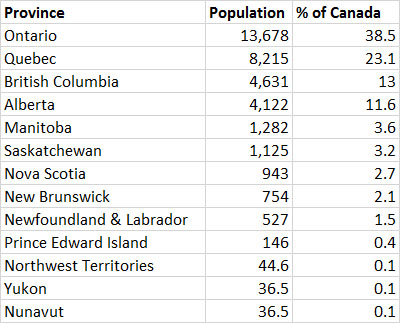
The highest rates of natural population increase (births minus deaths) occur in Nunavut (1.9%/year), the Northwest Territories (1.4%/y) (Table 11.3). In those territories, the populations are dominated by persons of First Nations and Inuit communities, which tend to have relatively large families and a higher rate of population growth. Those territories also have the lowest mortality rates, largely because of their comparatively young populations. People younger than 15 years comprised 30% of the population of NU and 21% of NWT in 2014, compared with a national average of 16% (Statistics Canada, 2014g). Overall, the age structure and growth rates of these territories is comparable to regions that are only beginning to pass through their demographic transition, and in that sense, they are anomalous with the rest of Canada.
Table 11.3. Demographic Parameters by Province and Territory. Data are per 1,000 people in the population and are annual rates (for 2014; note that a value of 10 per thousand per year is the same as 1% per year). Data for total increase include net migration. Fertility rate is the average number of births per woman aged 15-49 (in 2011). Data from Statistics Canada (2014e,f).
Alberta, Manitoba, and Saskatchewan have the fastest population growth rates among the provinces, averaging 1.6% per year (2014), which is equivalent to a doubling time of only 45 years. This rapid rate of population increase occurs in spite of a relatively small natural rate of population increase. Obviously, the populations of these provinces are growing because of high rates of immigration from other countries and from other regions of Canada.
The population of Canada is much denser in southern parts of the country, and especially in urbanized areas (Figure 11.6). This pronounced spatial pattern reflects the distribution of economic opportunities in Canada, most of which are related to urbanization, climate, and suitability of the land for agriculture.
Figure 11.6. Population density in Canada. The areas marked in red account for 75% of the population, while those in light-orange account for almost 25%. The area in white, which accounts for about 99% of the area of our country, holds less than 1% of the population. Map modified from Natural Resources Canada (2012).
Rural and Urban Populations
Until the latter half of the twentieth century, most Canadians lived in rural environments where they worked in agriculture and other country livelihoods. The proportion of Canadians living in the countryside has steadily decreased, from 87% in 1851 to 19% in 2011 (Figure 11.6).
Figure 11.7. Rural and Urban Populations in Canada. The total population (millions of people) and the percentage distribution of urban and rural Canadians are presented. The definitions of “rural” and “urban” have varies over time, but recently rural has meant people living outside populations centres smaller than 1,000 and outside areas with more than 400 persons/km2. Data from Statistics Canada (2014h).
In large part, this mass migration of people to urban areas has been caused by the mechanization of much of the routine labour in agriculture, fishing, forestry, mining, and other rural industries. In earlier times, most of this work was performed by humans or draft animals, but their muscle power has largely been replaced by various kinds of machinery. As a result, many fewer Canadians are employed in the rural economy, even though the financial value of the outputs from these sectors has increased greatly over time. The displaced rural people have moved to the towns and cities of Canada, where they earn their livelihoods in manufacturing, financial and service industries, commerce, government, and education.
As time passes, urban Canadians are living in increasingly larger centres of population. In 1871, only 2.9% of Canadians lived in centres with a population greater than 100-thousand people. In 2011, 63% of Canadians lived in the 20 largest cities in the country (Table 11.4), even though these metropolitan areas account for only 0.6% of the country’s landmass. In fact, 35% of Canadians live in the three largest cities.
Table 11.4. Cities of Canada. The populations of the 20 largest metropolitan areas of Canada, in decreasing order of population (in 2011). Percent increase refers to growth over the period 1971 to 2011. Data from Statistics Canada (1997, 2014i).
Population Policy
Most government planners, politicians, and leaders in business do not consider Canada to be overpopulated. In fact, they more typically believe that Canada is underpopulated and capable of comfortably absorbing considerable growth of its population. This view is debatable in view of the relatively intensive lifestyles of Canadians (which is typical of people living in developed countries) and the correspondingly large per-capita environmental impact. Nevertheless, continuing the population-growth paradigm is the predominant way of thinking among decision makers in Canadian governments and businesses. Consequently, Canada and its regions do not have well-developed population policies, other than those that establish targets and guidelines for the numbers and types of immigrants that will be allowed into the country.
In addition, Canadian governments have not encouraged other countries to develop their own population policies, especially those that are less-developed and have rapidly growing populations. Canadian governments also do not provide significant aid to those poorer countries to help them increase the availability of birth control. By not becoming involved in the population problems of less-developed countries, our governments avoid potentially high-profile controversy. However, this attitude contributes little to dealing with the global increase of the human population.
Governments within Canada also lack policies to encourage their citizens to have smaller families as a means of slowing the growth of national or regional populations. In fact, Canadian governments more typically pursue policies that are pro-natalist. This has been true of the government of Quebec, which in recent times has provided cash payments to women based on the number of children they have, and had provided daycare at greatly subsidized costs to parents. In addition, all provinces and the federal government provide substantial income-tax breaks to parents based on the number of children they are supporting. These tax benefits are intended to help lower-income families with the costs of child-rearing, but they can be interpreted as a pro-natalist aspect of the income-tax system.
Image 11.2. People living in wealthy countries, such as Canada, use resources intensively and therefore have a high per capita environmental impact. This is a view of the Eaton Centre in Toronto. Source: B. Freedman.
However, governments in Canada do permit their citizens to choose freely among a wide range of safe and effective birth control options. But this is not to say that all birth control methods are freely available across the country. For example, the governments of Prince Edward Island and New Brunswick restrict access to abortion by not funding services provided by private clinics, and in Nunavut there are no hospitals or clinics providing abortion. Consequently, many women must travel to another province, or even to the U.S., to have access to this medical service. Similarly, reproductive and family-planning education in schools varies considerably across Canada, and is often lacking in the comprehensiveness of its curriculum.
As was discussed in Chapter 10, abortion is an extremely contentious issue in Canada and elsewhere. The controversy has resulted in many public demonstrations and confrontations between pro-life (anti-abortion) and pro-choice (pro-abortion) groups. In a few instances, the patrons and personnel of abortion clinics have been illegally harassed or assaulted, and clinics have even been firebombed. In the 1990s, there were three cases of doctors who had provided abortion services being shot (in Ancaster, Vancouver, and Winnipeg), and in 2000 another was stabbed at his clinic (Vancouver).
Nevertheless, although abortion and other means of birth control remain controversial issues, Canadians who desire to control the number and spacing of their children do have relatively easy and inexpensive access to safe and effective means of birth control. While most Canadians take responsible advantage of this opportunity, it is not comparably available to most people in the world. Consequently, the natural rate of population increase in Canada is relatively small, while it is high in almost all poorer countries.
Moreover, immigration is a key contributor to population growth in Canada. It is well known that, other than descendants of its original Aboriginal peoples, Canada is almost entirely populated by immigrants and their offspring (accounting for about 97% of the total population). Canada has always had a relatively open immigration policy, and this continues today. In 2013, Canada admitted 259-thousand immigrants (permanent residents) from more than 200 countries, including 24-thousand refugees, equivalent to about 0.8% of the national population (Citizenship and Immigration Canada, 2014). The top source countries of immigrants were the Philippines (14%), China (12%), and India (10%). The overall population growth of Canada is about 1% per year, and net immigration accounts for about 60% of that growth. If not for its rather vigorous immigration rate, Canada would be close to a ZPG (zero population growth) condition.
There has always been some controversy over the immigration and refugee policies of Canada, as is true of all countries. Newcomers have contributed enormously to the economic development and cultural diversity of Canada – they have helped to make the country an interesting and prosperous place to live. These benefits must, however, be balanced against some of the downsides of continuing to have relatively open immigration policies, because of their contribution to rapid population growth. It is obvious that any population policy to reduce the rate of population growth in Canada must deal with the numbers of immigrants that the country accepts.
Canadian Focus 11.3. Birth Control and the Issue of Abortion.
The key reason for the growth of the human population has been a precipitous reduction of mortality rates, due to great improvements in sanitation and medical science. The most desirable way to slow population growth is to reduce the birth rate – it would never be acceptable to increase the death rate! Various family-planning options are available (see Chapter 10), including abstinence, the use of ways to prevent conception (birth-control pills, condoms, diaphragms, intrauterine devices), sterilization (vasectomy of the male or tubal ligation of the female), and termination of a pregnancy by abortion. All of these methods can result in safe and effective birth control, allowing parents to plan the size of their family and the spacing of births. Such choices generally result in smaller family sizes, and so contribute to decreased population growth.However, all of these methods of birth control are controversial to varying degrees. As a result, powerful interest groups, including major religions, have steadfastly opposed the use of some of the most effective methods of birth control. This dispute is a critical impediment to family planning, and to the implementation of effective population policies.
Abortion is, by far, the most contentious method of birth control. Many people view abortion as the taking of a human life, while others regard this medical procedure as a safe means by which a woman can choose to terminate an unwanted pregnancy. The situation is sometimes described as pitting the right to life of the fetus against the right of the mother to control her body and make decisions about her own life and lifestyle. Although both positions may share concerns about preventing unwanted pregnancies, the highly polarized views on abortion are essentially irreconcilable and so there is intense controversy. In Canada, the medical procedure of abortion is no longer a crime, but anti-abortion groups have continued to picket in public places, including hospitals and clinics where the service is provided. Most of the protest actions have been peaceful, but a few have not. There have been cases of violence in Canada and the United States, including arson and bombing of clinics, and physical attacks on doctors and other personnel involved with providing abortion as a medical service.
Henry Morgentaler is the most famous crusader for access to abortion services in Canada. He has been prosecuted several times under provisions of the Criminal Code that had effectively banned abortion services outside of a framework for access decisions in public hospitals. (The consent of a committee of doctors was required before an abortion could be provided, but some hospitals did not have such a committee, and some provinces did not allow them to be formed.) However, Morgentaler was never convicted by a jury of any of the charges laid against him (in four trials). Eventually, in 1988, ruling on an appeal by the Crown of a Morgentaler acquittal, the Supreme Court of Canada struck down the criminal code provisions as contravening the Charter of Rights and Freedoms, based on the lack of access for many women to abortion services in hospitals. That decision effectively legalized the availability of the medical procedure in Canada. In 2011, about 92.5-thousand abortions were reported in Canada (60% in private clinics; CIHI, 2014).
Although Henry Morgentaler has been a highly polarizing force within Canadian society, in July 2008 he was awarded the Order of Canada. This highest available and prestigious civilian honour was given in recognition of his notable contribution to Canadian society. Not surprisingly, the award was controversial.
An important context of the abortion debate is whether women, particularly those living in isolated regions and in poorer countries, should have reasonable access to alternative means of family planning (including birth-control drugs, condoms, and intrauterine devices). Many people believe that a successful population policy requires the education of women about health and reproductive issues, while ensuring that they have access to safe and effective means of birth control. The education of men to take responsibility for pregnancy is also crucial. However, in most cultures and circumstances, women have traditionally had the primary responsibility for pregnancy and childcare.
In addition to family planning, birth control, and abortion, some new issues related to human reproduction are also creating controversy. These include advances in reproductive technology leading to artificial insemination, test-tube babies, and cloning. Social changes, such as the acceptability of same-sex couples, are also altering the traditional allocation of childcare responsibilities.
Population issues are controversial, and they are uncomfortable for many people to examine and discuss in an objective manner. Yet they are too important to ignore, because sustainable economies will never be developed unless the population of humans is controlled.
Selected Web Resources Lifesite Canada, https://www.lifesitenews.com/ (a pro-life web site) Feminist Majority Foundation, https://feminist.org/ (a pro-choice web site) United Nations Population Fund, http://www.unfpa.org/
Conclusions
At the time of its “discovery” by European explorers, about 300-thousand Aboriginal people were living in what is now Canada. The Aboriginal population then collapsed due to the effects of introduced diseases, warfare, and social disruption, but it has now increased to more than 1 million. The colonization of New France began in 1604 but totaled only a few thousand immigrants; however, the descendants of these people today number more than 7 million. Immigration of English and other Europeans also began in the 17th century and continued to the present, to be joined in the 20th and 21st centuries by migrants from all parts of the world. Today, the population of Canada is more than 35 million and it continues to increase at about 1% per year, which is sufficient to double its size in another 70 years.
Questions for Review
- How did the population size of Aboriginal people in Canada differ before and after the European colonization?
- How have recent trends in population and growth rates differed among the provinces and territories of Canada?
- What are the relative importance of birth rate, death rate, immigration, and emigration to the population growth in the province or territory where you live?
Questions for Discussion
- How has the growth of the Canadian population changed over time? Discuss the factors influencing growth during the past several decades and those that will likely influence it into the near future.
- Compare the age-class structure of the Canadian population with that of a less-developed country. Explain the differences.
- What are the basic elements of the population policy of the government of Canada? Do you think they should be changed? If so, which aspects should be changed?
- Do you consider Canada to be underpopulated or overpopulated? Explain your reasons.
Exploring Issues
- Assume that the government of Canada is worried about the “aging” population and is thinking about implementing pro-natalist policies (such as giving money to parents who have additional children) as well as increasing the rate of immigration. You are a prominent environmental specialist and have been asked to make a presentation to a House of Commons committee that is considering these issues. What arguments would you use to convince the politicians that an increase in the rate of population growth is not desirable?
- The decision whether to have children and how many is complex. Make a list of the “benefits and costs” of having a child and how these change with increasing family size. Consider the personal benefits and costs (such as the satisfaction of nurturing children, and the cost of purchasing clothing) as well as those shared with society (such as medical and education costs).
References Cited and Further Reading
Bracq, J.C. 1926. The Evolution of French Canada. Macmillan, New York, NY.
Burger, J. 1990. The Gaia Atlas of First Peoples. Doubleday Dell, New York, NY.
Canadian Institute for Health Information (CIHI). 2014. Number of Induced Abortions Reported in Canada† in 2011, by Province/Territory of Hospital or Clinic. http://www.cihi.ca/CIHI-ext-portal/pdf/internet/TA_11_ALLDATATABLES20130221_EN
Citizenship and Immigration Canada. 2014. Canada – Permanent residents by category, 2009‑2013. https://web.archive.org/web/20140810132540/http://www.cic.gc.ca/english/resources/statistics/facts2013-preliminary/01.asp
Crosby, A.W. 1986. Ecological Imperialism: The Biological Expansion of Europe, 900–1900. London: Cambridge University Press.
Dumas, J. and A. Belanger. 1998. Report on the Demographic Situation in Canada, 1997. Statistics Canada, Ottawa, ON.
Kalbach, W.E. 1988. Population. pp. 1719-1722 In: The Canadian Encyclopedia, 2nd ed. Hurtig Publishers, Edmonton.
Knowles, V. 2007. Strangers at Our Gates: Canadian Immigration and Immigration Policy, 1540-2006. 2nd ed. Dundurn, Toronto, ON.
Leacy, F.H. 1983. Historical Statistics of Canada, 2nd ed. Statistics Canada, Ottawa, ON.
Natural Resources Canada. 2012. Atlas of Canada. Population Distribution, 2006. http://atlas.nrcan.gc.ca/site/english/maps/population.html
Ray, A. 1987. When two worlds meet. pp. 17-104 In: Brown, C. (ed.). The Illustrated History of Canada. Lester, Toronto, ON.
Statistics Canada. 1992. Postcensal Annual Estimates of Population by Marital Status, Age, Sex, and Components of Growth for Canada, Provinces, and Territories. Ottawa: Statistics Canada.
Statistics Canada. 1997. A National Overview—Population and Dwelling Counts. Ottawa: Statistics Canada.
Statistics Canada. 2012. Aboriginal Peoples in Canada: First Nations People, Metis and Inuit, National Household Survey, 2011. Catalogue no. 99-011-X2011001, Statistics Canada, Ottawa, ON. http://www12.statcan.gc.ca/nhs-enm/2011/as-sa/99-011-x/99-011-x2011001-eng.pdf
Statistics Canada. 2014a. Population by year, by province and territory. CANSIM, Table 051-0001. http://www5.statcan.gc.ca/cansim/a26?lang=eng&retrLang=eng&id=0510001&&pattern=&stByVal=1&p1=1&p2=1&tabMode=dataTable&csid= Accessed December, 2014.
Statistics Canada. 2014b. Population Projections for Canada (2013 to 2063), Provinces and Territories (2013 to 2038). Publication 91-520-X. http://www.statcan.gc.ca/pub/91-520-x/2014001/c-g-eng.htm
Statistics Canada. 2014c. Population by sex and age group, 2014. CANSIM, Table 051-0001. http://www.statcan.gc.ca/tables-tableaux/sum-som/l01/cst01/demo10a-eng.htm
Statistics Canada. 2014d. Population by year, by province and territory. CANSIM, Table 051-0001. http://www.statcan.gc.ca/tables-tableaux/sum-som/l01/cst01/demo02a-eng.htm
Statistics Canada. 2014e. Components of population growth, by province and territory. CANSIM, Table 051-0004. http://www.statcan.gc.ca/tables-tableaux/sum-som/l01/cst01/demo33a-eng.htm
Statistics Canada. 2014f. Births and total fertility rate, by province and territory. CANSIM, Table 102-4505. http://www.statcan.gc.ca/tables-tableaux/sum-som/l01/cst01/hlth85b-eng.htm
Statistics Canada. 2014g. Population by sex and age group, by province and territory. CANSIM, Table 051-0001. http://www.statcan.gc.ca/tables-tableaux/sum-som/l01/cst01/demo31a-eng.htm
Statistics Canada. 2014h. Population, urban and rural, by province and territory (Canada). From 2011 Census of Population. http://www.statcan.gc.ca/tables-tableaux/sum-som/l01/cst01/demo62a-eng.htm
Statistics Canada. 2014i. Population and dwelling counts, for census metropolitan areas, 2011 and 2006 censuses. From 2006 and 2011 Census of Population. http://www12.statcan.gc.ca/census-recensement/2011/dp-pd/hlt-fst/pd-pl/Table-Tableau.cfm?T=205&S=3&RPP=50
Trovato, F. 2008. Canada's Population in a Global Context: An Introduction to Social Demography. Oxford University Press, Toronto, ON.
Young, B. and J.A. Dickinson. 1988. A Short History of Quebec: A Socio-Economic Perspective. Copp Clark Pitman, Toronto, ON.
World Resources Institute. 2008. EarthTrends. The Environmental Information Portal. Washington, DC.

